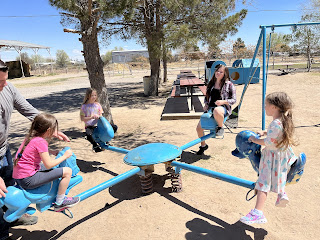It has been a busy couple of months, and there is no sign that it will be slowing down any time soon. Family funerals and weddings, personal trips, Young Women camp and a church youth conference, a high school reunion...Some people would suggest simplifying the schedule, prioritizing some things and cutting out the rest. Nonsense! Sometimes the best thing to do is lean into the busy, and with that slightly masochistic perspective we dive into our first summer adventures.
One of the things the southwest is famous for—or notorious,
depending on your perspective—are the missions.
Thick-walled adobe structures, remnants of the Spanish colonization of
the New World, dot the mesas and dry creeks of the desert west.
There are three near El Paso, part of the Camino Real (Royal
Road or King’s Highway) comprised of trails and trade routes that was the
primary route for the Spanish colonization of what is today Texas.
San Elizario was established as a presidio, or
military fort, in 1789.
Nothing really
remains of the original fort; the chapel was actually built in 1877.
A large, chalky white building in the distinctive
rounded Traditional Spanish style, the walls are massively thick for both
cooling and defensive purposes.
It’s
still an active Catholic church.
Out of
respect, we didn’t take pictures inside, even though there was a pair of
incongruous giant pink and blue plaster angels that were practically begging
for a photo op.
To be honest, the rest of the historic parts of the town
were more interesting than the chapel itself. Besides a couple of signs, the
chapel had very little information about it.
San Elizario is a rather unprepossessing place; like many small desert
towns, it is little more than a stretch of dusty, wind-scoured buildings with
sun-faded paint. The crown of San
Elizario is the historic district, a handful of stone and adobe structures
dating back to the 1800s. The mercantile
has some of the original stone walls that have been refurbished over the centuries;
a nearby building has the massive wooden doors of the original chapel. At the mercantile—which pulls double duty as
a thrift store and the local military veterans museum—the proprietor was proud
to point out that one of the oldest streets in Texas ran just outside the door,
and how San Elizario was established as a town over 400 years ago.

Rick was taken with the veterans museum, a collection of
photographs and memorabilia from families in the town.
It was simply done, just walls of pictures
and lovingly mounted uniforms and medals, but it was impactful.
My personal favorite stop was the jail. A gnarled old gentleman with a cane and a
magnificent beard showed us the original steel jail cells and told us stories
of Billy the Kid (William Bonney, for you history nerds) and the Salt Wars. Seriously, the best part about any touristy
place is the people. One, the docents
and hosts are generally dying to talk to someone; their job is very boring
otherwise. Two, they always have the
coolest stories to share. A generational
resident of San Elizario, Mr. Sanchez was simply delightful, and it was fun
hearing the history intermingled with his own personal opinions about the anecdotes
and his family’s history in the town.
His name also made my Book of Life-loving heart happy.
Side note: remember those flooded salt flats I dragged the
kids to last summer?
Those are actually
part of the salt lakes at the center of the aforementioned Salt Wars, which
were a political turf war over the rights to mine the salt flats at the base of
the Guadalupe Mountains. Another side trip turned history lesson. Boom.
When we were done trundling through history and dust, we
headed 5 minutes down the road to Licon Dairy.
Licon Dairy is a stable-to-table working dairy farm with a
petting zoo and questionably placed restaurant that specializes in burgers and
asado cheese.
Armed with
reasonably-priced animal feed, we descended on the goats, ducks, and miniature
donkeys in a tornado of petting and squeals.
The mini donkeys were a general favorite, but the ostriches also won a
few fans despite trying to swallow entire hands. Rick developed a friendship
with a rather belligerent macaw.
The
cows, perhaps aware of their ultimate fate thanks to the smoke drifting over from
the grill, were somewhat standoffish.
Or
maybe they just preferred hay to dried corn.
The more stubborn of us persisted until we patted some cow noggins.
After a brief stop at the playground, which
was delightfully stocked with the deathtraps of an 80s childhood, we headed
back home.
They were just small adventures, but they ticked all the
boxes—local flavor, practically free, and not my couch or Walmart.
If I’ve learned nothing else from spending my
entire adult life on the move, I’ve learned that life is more fun when you get out
and do instead of sit down and don’t. Sometimes they’re underwhelming, and
sometimes you find a gem.
The girls are
already asking about returning to Licon Dairy, and there are two more missions
on this stretch of the Mission Trail.
Hopefully they’ll be a little more exciting than San Elizario.
Personally, I’m keeping my fingers crossed for another
Sanchez.






















No comments:
Post a Comment